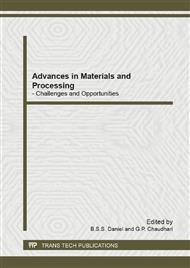p.219
p.224
p.228
p.235
p.240
p.245
p.250
p.255
p.260
Synthesis and Characterization of LiFePO4-C/ PANI Composite for Cathode Material of Lithium Ion Battery
Abstract:
In-situ polymer coated LiFePO4-C composite material has been synthesized using different oxidizing agents viz. (NH4)2S2O8, KMnO4 and K2Cr2O7. Polyaniline (PANI) with chains having diameter ≤ 200 nm have been grown separately by self oxidation process of aniline monomers using the above oxidizing agents. For the synthesis of LiFePO4-C active material, initially raw material FePO4/PANI has been synthesized by chemical precipitation method and added with LiCOOCH3 followed by heat treatment at 700°C under reducing (Ar/H2=90/10) atmosphere for 16 hrs. The synthesized LiFePO4-C material has particle size of about 100 nm. The polymer coated LiFePO4-C composite was synthesized by undergoing in-situ polymerization of aniline monomers added with fixed quantity of LiFePO4-C. XRD analysis reveals formation of single phase pure active material LiFePO4-C and mixed phase containing LiFePO4 to FePO4 for polymer coated LiFePO4-C composite. The carbon content in the LiFePO4-C was estimated to be 5 wt%, however, the PANI content in the composites was different with different oxidizing agent. These PANI contents in the composites synthesized with (NH4)2S2O8, KMnO4 and K2Cr2O7 are 14, 15 and 17 wt% respectively which have been estimated by thermal gravimetric analysis (TGA) of the materials. Electrical conductivities of the composite materials were determined by Impedance spectroscopy method. The composite material synthesized with (NH4)2S2O8 has higher conductivity compared to those synthesized with KMnO4 and K2Cr2O7. The higher conductivity of the composite synthesized with (NH4)2S2O8 may be attributed to the presence of partial chain structure in polymer coating as seen by microstructural observations on the composite.
Info:
Periodical:
Pages:
240-244
Citation:
Online since:
November 2012
Authors:
Keywords:
Price:
Сopyright:
© 2012 Trans Tech Publications Ltd. All Rights Reserved
Share:
Citation:


